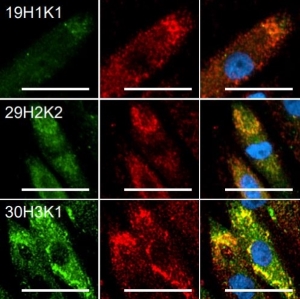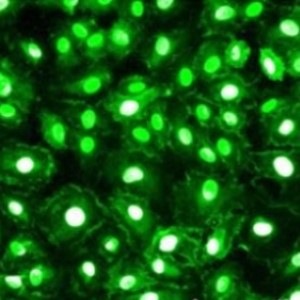Product Details
Out of stock - Currently unavailable Substance P is a neuropeptide derived from preprotachinin. Substance P is widely distributed in the central and peripheral nervous system. In sensory ganglia, it is expressed by small sensory neurons and is transported to their central and peripheral terminals. The role of substance P in sensory transmission has been studied extensively, and its involvement in nociception and chronic pain is well established. Our guinea pig anti-substance P antibody provides an excellent tool for multicolor immunofluorescence experiments. |
Supporting Products
| Name | Catalog # | Size |
|---|---|---|
| Substance P | P14103 | 100 ug Blocking Peptide |
- Product Reviews- - Rating:
Leave a review for this product and you could be eligible for a $10 Starbucks gift card.
- Product Publications
Product Publications
- David J. Barker, Shiliang Zhang, Huiling Wang, David J. Estrin, Jorge Miranda-Barrientos, Bing Liu, Rucha J. Kulkarni, Junia Lara de Deus, and Marisela Morales. (2023). Lateral Preoptic Area Glutamate Neurons Relay Nociceptive Information to the Ventral Tegmental Area. Cell Reports 42, 113029. doi: 10.1016/j.celrep.2023.113029
- Vijayan Gangadharan, Hongwei Zheng, Francisco Taberner, Jonathan Landry, Timo Nees, Jelena Pistolic, Nitin Agarwal, Deepitha Mannich, Vladimir Benes, Moritz Helmstaedter, Bjorn Ommer, Stefan Lechner, Thomas Kuner, and Rohini Kuner. (2022). Neuropathic Pain Caused by Miswiring and Abnormal End Organ Targeting.Nature. doi: 10.1038/s41586-022-04777-z
- Marc-Andre Dansereau, Elora Midavaine, Valerie Begin-Lavallee, Mounir Belkouch, Nicolas Beaudet, Jean-Michel Longpre, Stephane Melik-Parsadaniantz, and Philippe Sarret. (2020). Mechanistic Insights Into the Role of the Chemokine CCL2/CCR2 Axis in Dorsal Root Ganglia to Peripheral Inflammation and Pain Hypersensitivity. doi: 10.21203/rs.3.rs-95407/v1
- Khaled Abdallah, Francis Nadeau, Francis Bergeron, Sylvie Blouin, Véronique Blais, Kelly M. Bradbury, Christine L. Lavoie, Jean-Luc Parent & Louis Gendron. (2018). Adeno-associated virus 2/9 delivery of Cre recombinase in mouse primary afferents. Scientific Reports volume 8, Article number: 7321 (2018) doi:10.1038/s41598-018-25626-y
- Chien-Cheng Liu, Yong-Jing Gao, Hao Luo, Temugin Berta, Zhen-Zhong Xu, Ru-Rong Ji & Ping-Heng Tan. (2016). Interferon alpha inhibits spinal cord synaptic and nociceptive transmission via neuronal-glial interactions. Scientific Reports, 6, Article number: 34356. doi: 10.1038/srep34356
- Leanne M. Ramer, A. Peter van Stolk, Jessica A. Inskip, Matt S. Ramer and Andrei V. Krassioukov. (2012). Plasticity of TRPV1-expressing sensory neurons mediating autonomic dysreflexia following spinal cord injury. Front. Physiol., doi: 10.3389/fphys.2012.00257
- Tong Liu, Temugin Berta, Zhen-Zhong Xu,Chul-Kyu Park,Ling Zhang, Ning Lü, Qin Liu, Yang Liu, Yong-Jing Gao, Yen-Chin Liu, Qiufu Ma, Xinzhong Dong, and Ru-Rong Ji. (2012). TLR3 deficiency impairs spinal cord synaptic transmission, central sensitization, and pruritus in mice. J Clin Invest. 122(6): 2195–2207. doi: 10.1172/JCI45414
- Xiaoyang Zhang, Kristy L.Douglas, Huixia Jin, Bassem M. Eldaif, Rashid Nassar, Matthew O. Fraser, and Paul C. Dolber. (2008). Sprouting of substance P-expressing primary afferent central terminals and spinal micturition reflex NK1 receptor dependence after spinal cord injury. Am J Physiol, 295: R2084-R2096. doi: 10.1152/ajpregu.90653.2008
If you've used this product in a publication, let us know. Email pshuster@neuromics.com, with the publication details and you could be eligible for an Amazon gift card.
- Related Products
Related Products
Images
Immuofluorescent detection of Substance P in rat spinal cord dorsal horn (red fluorescence). DAPI (blue) was used as counter stain.
Immuofluorescent detection of Substance P in rat spinal cord dorsal horn (red fluorescence). DAPI (blue) was used as counter stain.
Substance P staining of trigeminal ganglia from P3-P5 rat pups. BMC Neuroscience 2010, 11:32doi:10.1186/1471-2202-11-32
Substance P staining of trigeminal ganglia from P3-P5 rat pups. BMC Neuroscience 2010, 11:32doi:10.1186/1471-2202-11-32
Mouse spinal code stained with Substance P (Red), nucelar counterstained with DAPI (blue) Working dilution 1:200.
Mouse spinal code stained with Substance P (Red), nucelar counterstained with DAPI (blue) Working dilution 1:200.
Substance P antibody in rat spinal cord
Substance P antibody in rat spinal cord






